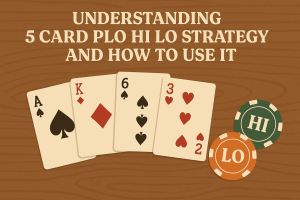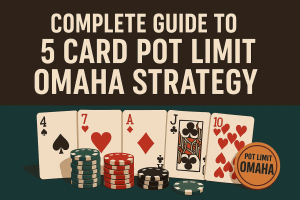Pot-Limit Omaha is a thrilling and action-packed variant of poker, but when you move to the 5 card PLO format, the game becomes even more dynamic. With an extra hole card in play, the range possibilities multiply significantly, demanding deeper strategic thinking. In this guide, we will explore how to build a solid 5 card PLO strategy and what you need to win more consistently, especially in 5 card PLO cash games.
Understanding the Fundamentals of 5 Card PLO
Before diving into the advanced strategies, it’s crucial to understand how 5 card PLO differs from its 4 card counterpart. In this variant, each player is dealt five private cards and must use exactly two of them along with three community cards to make the best five-card hand. The additional card increases the number of potential hand combinations and makes drawing hands more prominent.
This change may seem small, but it dramatically impacts equity calculations, pre-flop hand strength, and post-flop decision-making. Without a foundational grasp of these elements, even seasoned Omaha players may find themselves at a disadvantage in a 5 card PLO cash game.
Pre-Flop Strategy in 5 Card PLO
In 5 card PLO, pre-flop play is more complex due to the greater number of combinations available. Hands that might be playable in regular PLO can become liabilities when up against stronger draws and more connected holdings.
You should prioritize hands that are highly connected, double-suited, and capable of making the nuts in multiple ways. Avoid playing ragged hands or holdings that only rely on one pair or a weak flush draw. Suited Aces with straight potential, such as A♠ K♠ Q♠ J♦ T♦, are excellent starting hands due to their flexibility and high equity.
Another key tip for your 5 card PLO strategy is to play tighter from early positions and open up your range from the cutoff and button. Positional advantage is even more critical in 5 card PLO cash games, where decisions often come down to narrow equity margins.
Importance of Equity Realization
Equity realization in 5 card PLO is about how well your hand performs from flop to river. Because players have more cards, post-flop play can escalate quickly, and drawing to the nuts becomes essential. Even top pairs or low flushes are often not enough.
The ability to realize your equity depends on several factors: position, hand structure, board texture, and your opponent’s tendencies. For instance, if you have a hand like J♥ T♥ 9♥ 8♠ 7♠ on a board showing Q♥ 9♣ 3♦, your potential to make straights or flushes increases your hand’s value, even without current top pair. However, not all drawing hands are created equal. Look for opportunities where your draw has nut potential and multiple outs to strong hands.
Post-Flop Decision Making
Once the flop hits, players often find themselves in multiway pots with strong draws. This is where experience and reading the board accurately become indispensable. You should focus on maximizing value when ahead and minimizing losses when you’re behind or drawing thin.
Don’t be afraid to fold marginal hands. Many new players fall into the trap of overplaying weak top pairs or chasing non-nut draws. Successful post-flop strategy in 5 card PLO involves a careful balance of aggression and discipline. You must also be aware of blockers — having one or more cards that block your opponent’s likely draws can significantly alter your decision-making process.
Stack Sizes and Pot Control
Pot control is a major consideration in any PLO format, but it’s especially important in 5 card PLO cash games where swings can be brutal. Understanding stack sizes helps you decide when to commit to the pot or back off. Shallow stacks reduce implied odds and limit your post-flop maneuverability, while deeper stacks allow more strategic depth.
If you’re playing deep stacked, be more cautious with non-nut draws and marginal holdings. Look to play big pots only with strong made hands or powerful redraws. In short-stacked scenarios, the game leans more toward push-or-fold dynamics, so make sure your hand has immediate strength before going all-in.
Reading Opponents and Adjusting Your Strategy
One of the most overlooked aspects of any 5 card PLO strategy is adapting to your opponents. Observing tendencies such as how often they see flops, how aggressive they are post-flop, and whether they overvalue weak hands can give you a significant edge.
If your opponent is overly loose, tighten up and punish their mistakes by value betting your strong hands. Against tight players, you can steal more pots and apply pressure on scare cards. The ability to switch gears and adjust your strategy mid-session is what separates average players from long-term winners.
5 Card PLO Cash Game Dynamics
Cash games have a different rhythm compared to tournaments, and in 5 card PLO, that difference is amplified. Players are more willing to chase deep-stack hands and the money doesn’t reset after a bust-out, so bankroll management is key.
It’s vital to select the right table. Games with passive, loose players will naturally offer more value than those filled with aggressive regulars. Table selection is as much a part of your 5 card PLO cash game success as the cards you are dealt.
Be patient and disciplined. Don’t get drawn into every pot, and remember that the long-term profits come from consistently getting your money in with the best of it. Variance in 5 card PLO is notoriously high, so emotional control and smart decision-making will keep your win rate steady.
Bluffing and Semi-Bluffing in 5 Card PLO
Bluffing is an advanced technique in 5 card PLO and should be used selectively. Because players hold more cards, the likelihood of someone connecting with the board is higher, making pure bluffs riskier.
Semi-bluffing, however, is far more viable. If you hold a strong draw with multiple outs, betting aggressively on the flop or turn can serve two purposes: building the pot when you hit, and taking down the pot if your opponent folds. The key is knowing when to apply pressure and when to slow down based on opponent tendencies and board texture.
Common Mistakes to Avoid
Even experienced players fall into traps that can cripple their long-term profitability. One major mistake is playing too many hands out of position. Another is overvaluing single-pair hands or chasing draws without proper pot odds.
Another frequent misstep is ignoring the value of blockers and overestimating weak full houses or non-nut flushes. In high-level games, recognizing these nuances is vital to stay ahead of the competition. Always strive to evaluate your hand in the context of the board and potential opponent holdings.
Using Tools and Hand Replays to Improve
Analyzing your sessions after play is an effective way to refine your 5 card PLO strategy. Many tools allow you to replay hands, evaluate your equity, and compare decisions against solver recommendations.
Tracking software and equity calculators can offer insights into where your strategy needs adjustment. While not necessary for casual play, these tools become invaluable if you’re serious about excelling in 5 card PLO cash games. For further reading, consider checking resources like this advanced guide on 5 Card PLO.
Final Thoughts: Putting It All Together
Mastering 5 card PLO is a journey that requires patience, practice, and a keen eye for strategy. With more potential combinations than traditional PLO, the game offers exciting possibilities — and formidable challenges. Success in this variant hinges on a deep understanding of hand selection, board reading, equity realization, and psychological warfare.
By building your knowledge, avoiding common pitfalls, and playing with discipline, you’ll not only win more but also gain a deeper appreciation for the complexities of 5 card PLO cash games. Apply the strategies discussed here consistently, and you’ll begin to see measurable improvements in your results at the tables.




